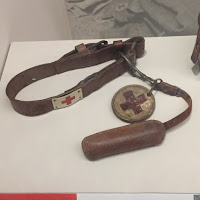Wounded: Conflict, casualties and care
Fascinating exhibition at the Science Museum looking at how the wounded were treated in the
First World War and the innovations that were driven by the lessons learnt.
Evening Standard
I thought I had a
good knowledge of the First World War but I learned so much from this
exhibition. The first section looked at the chain of evacuation of the injured
from the battlefield with displays on each stage from treatment on the front
line, though dressing and clearing stations to hospitals and the journey home.
There was a wonderful model of a hospital train and I found the front line
stretcher moving.
I also loved the
Red Cross dogs collar. I hadn’t realised the dogs went out onto the battle
field and sniffed to find men who were
still alive. They then pulled a piece of clothing off the wounded and took it
back as a sign of life.
The next section
looked at the technological breakthroughs including Marie Curie bringing x-rays to the front line, a new splint which
was developed as they realised that 80% of soldiers with fractured thigh bones
died due to poor splint design leading to infection and blood transfusions
being developed.
I had never realised
before that the infection rates were so high on the Western Front because they
were fighting on well manured farmland or that the football rattles of the
1920s were often gas rattles from the front line.
The last section
looked at what happened to soldiers when they got back to Britain both their
immediate and long term care. It was great to see the Tonks pictures of the
facial surgery done by Harold Gilles again. It was interesting to see how a lot
of the work was done by soldiers with similar problems joining together and
addressing their specific issue. Many of these organisations such as St
Dunstans, now called Blind Veterans UK, are still around today. It also looked
at the developments in mental health as people began to understand Post-Traumatic
stress.
Showing a video
about current front line medical practice and treatment and support for
returning soldiers at the end of the show was a nice touch and it was
fascinating to see many of the lessons learned 100 years ago still being used.
Closes January
2018.
Reviews
GuardianEvening Standard




Comments